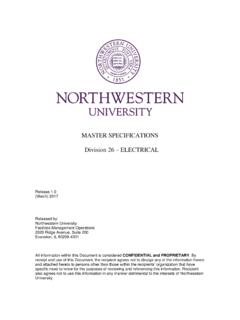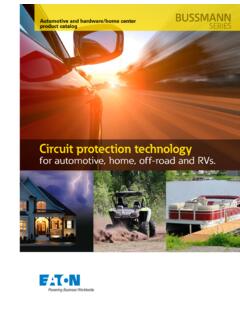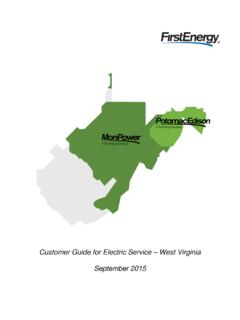Transcription of Major Code Changes for 2020 NEC - PPRBD
1 2880 International Circle Colorado Springs, CO 80910 Telephone 719-327-2880 Web address Major Code Changes for 2020 NEC: (This list is not inclusive of all Changes ) The 2020 NEC will be effective on permits issued as of July 31, 2021 1) (A). Disconnect Identification. Along with identifying the purpose of a disconnecting means, in other than one and two family dwellings, the marking shall include the identification of the circuit source that supplies the disconnecting means. 2) (C) (2). Large Equipment entrance and egress from working space. The change here is that open equipment doors cannot impede the entry to or egress from the working space. 3) (A). Dwelling Units. All 125-volt thru 250-volt receptacles installed in (A) (1) thru (A) (11) single phase circuits 150-volts to ground or less shall be GFCI protected.
2 4) (A) (5). Basements. GFCI protection required throughout the basement, not just unfinished areas of a basement. 5) (B) (2). Other than Dwelling units. GFCI protection required in kitchens or areas with a sink and permanent provisions for either food preparation or cooking. 6) (D) Specific Appliances, & (E) Equipment Requiring Servicing. GFCI protection required for receptacles for specific appliances ( (A)) when not already protected by one of the methods in (B), and receptacles specific to the equipment outlined in shall be GFCI protected. 7) (F) Outdoor Outlets. All outdoor outlets for dwellings, other than those covered in (A) (3), Exception to (3), that are supplied by branch circuits rated 150 volts to ground or less, 50-amp or less, shall have ground fault circuit interrupter protection for personnel.
3 (Example would be an A/C unit) 8) (C). AFCI protection required in Guest Rooms and Guest Suites, and Patient Sleeping Rooms of Nursing Homes and limited Care Facilities. 9) (D). Branch Circuit Extensions or Modifications - Dwelling units, Dormitory units, Guest Rooms and Guest Suites. Where the branch circuit wiring for any areas in (A) (B) or (C) is replaced, modified or extended it shall be AFCI protected. The exception for the extensions not over 6ft in length and not including any additional outlets or devices is still applicable. 10) (C) (2). Island and Peninsular Countertops and Work Surfaces. (a) At least one receptacle shall be installed for the first 9sqft or fraction thereof, of the countertop or work surface, and an additional receptacle for each additional 18sqft or fraction thereof.
4 (b) at least one receptacle outlet shall be installed within 2ft of the outer end of a peninsular countertop or work surface. Additional outlets required, shall be permitted to be located as determined by the installer, designer or owner. 11) (A) (1). Habitable Rooms. The change here is that the required wall mounted control device for lighting outlets in habitable rooms must be located near the entrance on a wall. (Already common practice) 12) (B). Common Supply Equipment. Where feeder conductors originate in the same panelboard, switchboard, switchgear, or distribution equipment, and each feeder terminates in a single disconnecting means, not more than six feeders shall be permitted. Where more than one feeder is installed, the disconnects shall be grouped in the same location.
5 13) Effective January 2023, All pressure connectors and devices for splices or taps installed on service conductors are to be Listed and Marked as Suitable for use on the line side of the service equipment or equivalent . 14) (A) thru (D). surge Protection. All services supplying dwelling units shall be provided with a surge - protective device. Must be Type 1 or Type 2 SPD. Applies to service equipment being replaced. 15) Maximum Number of Disconnects ( 6 Handle Rule). The change here is that 6 separate service disconnects only allowed in separate enclosures or separate compartments. 16) Emergency Disconnects. For one and two family dwellings units, service conductors shall terminate in a service rated disconnecting means at a readily accessible location outdoors.
6 Each disconnecting means shall be marked Emergency Disconnect Service Disconnect 17) (A) thru (C). Arc Energy Reduction (Fuses). EFFECTIVE JANUARY 1 2020. Reminder that Arc Energy Reduction is now required where fuses are employed and rated 1200-amp or higher. (C) is new in the 2020 NEC requiring the arc energy reduction system testing by primary current injection or other approved method when first installed on site.(Some exceptions apply) 18) (A) thru (C). Arc Energy Reduction (Breakers). Breakers rated 1200 Amp or higher must utilize one of the methods of reducing arc energy, and documentation shall be provided showing that the method chosen to reduce the clearing time is set to operate at a level below the available arcing current.
7 Temporary adjustment of the instantaneous trip setting to achieve arc energy reduction shall not be permitted. (C) is new in the 2020 NEC requiring the arc energy reduction system testing by primary current injection or other approved method when first installed on site. (Some exceptions apply) 19) (C) (3). Grounding Electrode Conductor and Bonding Jumper Connections to Grounding Electrodes. The change here is that rebar (UFER) cannot be used as a conductor to connect other electrodes in the system. 20) (B). Sizing Equipment Grounding Conductors. When ungrounded conductors are increased in size for any reason other than as required by (B) or (C), wire type EGC s shall be increased in size proportionately to the increase in circular mil area of the ungrounded conductors.
8 21) Exit Enclosures (Stair Towers). Where an exit enclosure is required to be separated from the building, only electrical wiring methods serving equipment permitted by the authority having jurisdiction in the exit enclosure shall be installed within the exit enclosure. 22) Article 310 Changes . Revised with new table designations. MV cable and conductors have been relocated to new Article 311. Table (B) (16) has been renamed Table , and new Table for dwelling unit ampacities for services and feeders is back when no de-rating is required. 23) (C). Boxes at Ceiling Suspended Paddle Fan Outlets. Outlet boxes in the ceilings of habitable rooms in a location acceptable for the installation of a suspended paddle fan shall be either: 1) Listed for the sole support of a suspended paddle fan, or 2) a standard outlet box providing access to structural framing capable of supporting a suspended paddle fan bracket or equivalent.
9 24) (G) (1) & (2). Receptacle Orientation. (1) Receptacles shall not be installed in a face up position in countertops or work surfaces unless Listed for countertop and work surface applications. (2) Under Sinks. Receptacles shall not be installed in a face up position in the area below a sink. 25) (C). Bathtub and Shower Space. Receptacles shall not be installed within a zone measured 3ft horizontally and 8ft vertically from the top of the tub rim or shower stall threshold. This is all encompassing and shall include the space directly over the tub or shower. Exception: In bathrooms with less than the required zone the receptacle(s) shall be permitted to be installed opposite the bathtub or shower stall on the farthest wall within the room.
10 26) Tamper Resistant Devices. TR devices for all 15 and 20-amp 125 and 250 volt receptacles are now required to be installed in common areas of multifamily dwellings, common areas of hotel and motels, Dormitory units, and Assisted living facilities. 27) Short Circuit Current Rating. In other than one and two family dwellings, the available fault current and the date the calculation was performed shall be field marked on each Switchboard, switchgear, and panelboard. 28) Exception 1. Overcurrent Protection. DELETED. This was a companion section to dealing with the 6 handle rule. 29) (C). Installation in Fire Resistive Construction. Recessed Luminaires not Listed for use in Fire Resistant Rated Construction shall not be installed in fire resistive rated construction unless is satisfies one of the following conditions: 1) Shall be Listed for use in Fire Resistant Rated Construction 2) The luminaire shall be installed in or used with a luminaire enclosure that is Listed for use in a Fire Resistant Rated Construction.



